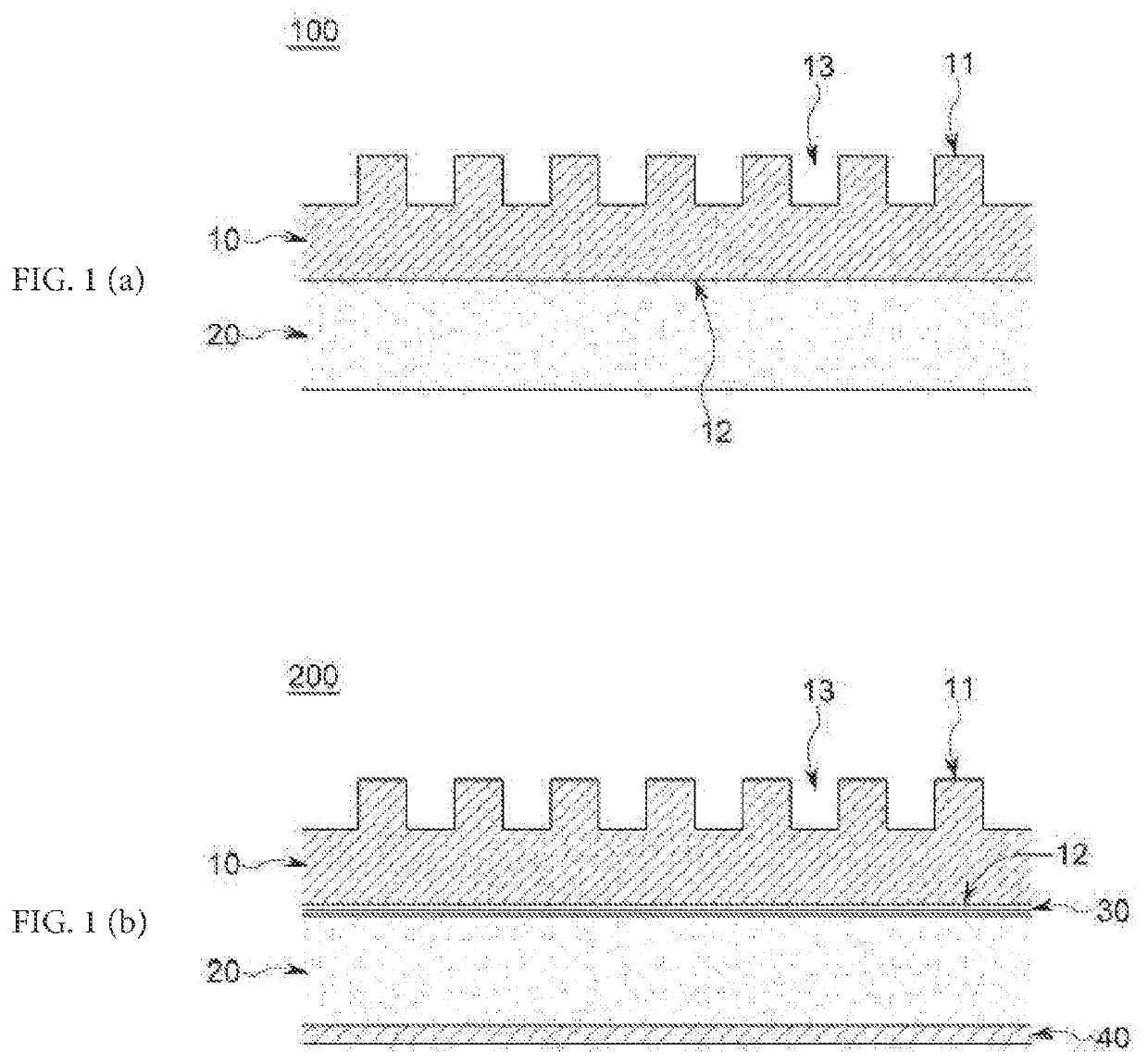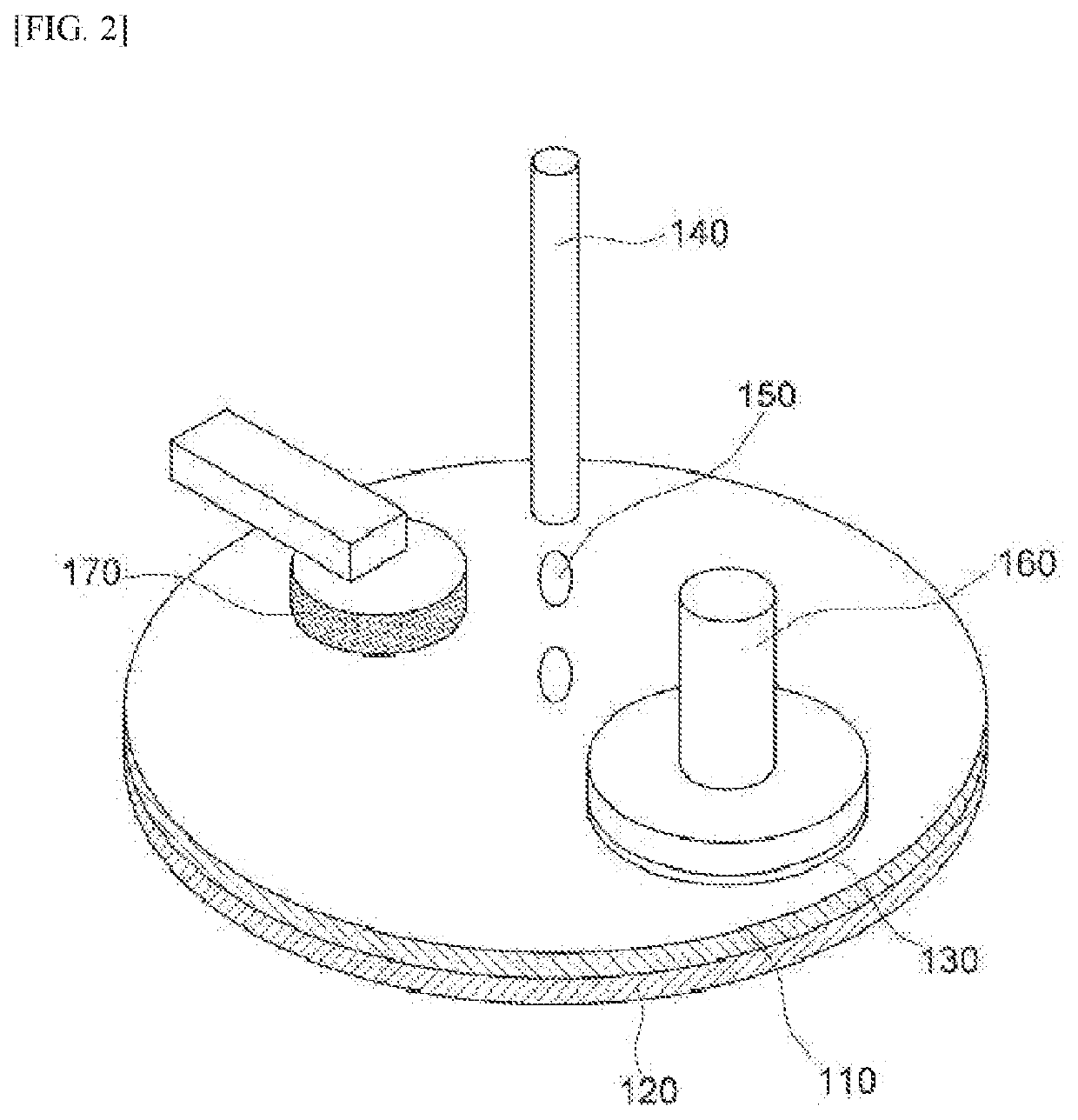Polishing pad and method of fabricating semiconductor device using the same
a technology of polishing pad and semiconductor substrate, which is applied in the direction of grinding/polishing apparatus, grinding machine, manufacturing tools, etc., can solve the problems of reducing the size of individual chips, increasing the complexity of the pattern of each layer, and reducing the polishing process. , to achieve the effect of reducing the number of defects on the semiconductor substrate during the polishing process
- Summary
- Abstract
- Description
- Claims
- Application Information
AI Technical Summary
Benefits of technology
Problems solved by technology
Method used
Image
Examples
example 1
[0210]2,4-TDI and 2,6-TDI were mixed together at the relative weight ratios described in Table 1 below, based on 100 parts by weight of the total weight of the diisocyanate component. PTMG and DEG were mixed together at the relative weight ratio described in Table 1 below, based on 100 parts by weight of the total weight of the polyol component. A raw material mixture was prepared by mixing 220 parts by weight of the total amount of the polyol with 100 parts by weight of the total amount of the diisocyanate. A preliminary composition containing a urethane-based prepolymer was prepared by placing the raw material mixture in a four-neck flask and then allowing the mixture to react at 80° C. The content of isocyanate groups (NCO groups) in the preliminary composition was adjusted to 6 wt %, 4,4′-methylenebis(2-chloroaniline) (MOCA) as a curing agent was added to the preliminary composition so that the molar ratio of the NH2 groups of the MOCA to the NCO groups in the preliminary compos...
example 2
[0211]2,4-TDI, 2,6-TDI and H12MDI were mixed together at the relative weight ratios described in Table 1 below, based on 100 parts by weight of the total weight of the diisocyanate component. PTMG and DEG were mixed together at the relative weight ratio described in Table 1 below, based on 100 parts by weight of the total weight of the polyol component. A raw material mixture was prepared by mixing 220 parts by weight of the total amount of the polyol with 100 parts by weight of the total amount of the diisocyanate. A preliminary composition containing a urethane-based prepolymer was prepared by placing the raw material mixture in a four-neck flask and then allowing the mixture to react at 80° C. The content of isocyanate groups (NCO groups) in the preliminary composition was adjusted to 8.0 wt %, 4,4′-methylenebis(2-chloroaniline) (MOCA) as a curing agent was added to the preliminary composition so that the molar ratio of the NH2 groups of the MOCA to the NCO groups in the prelimin...
experimental example 3
Properties of Polishing Layer or Polishing Pad
[0218](1) Hardness
[0219]Each of the polishing layers of Examples 1 and 2 and Comparative Examples 1 and 2 was processed to a thickness of 2 mm, and then cut to a size of 5 cm (width)×5 cm (length), thus preparing samples. After each of the samples was stored at a temperature of 25° C. for 12 hours, and then the Shore D hardness thereof was measured using a durometer.
[0220](2) Tensile Strength
[0221]Each of the polishing layers of Examples 1 and 2 and Comparative Examples 1 and 2 was processed to a thickness of 2 mm, and then cut to a size of 4 cm (width)×1 cm (length), thus preparing samples. For each of the samples, the maximum strength value immediately before breaking was measured using a universal testing machine (UTM) at a speed of 50 mm / min.
[0222](3) Elongation
[0223]Each of the polishing layers of Examples 1 and 2 and Comparative Examples 1 and 2 was processed to a thickness of 2 mm, and then cut to a size of 4 cm (width)×1 cm (leng...
PUM
| Property | Measurement | Unit |
|---|---|---|
| temperature | aaaaa | aaaaa |
| PDI | aaaaa | aaaaa |
| tensile strength | aaaaa | aaaaa |
Abstract
Description
Claims
Application Information
 Login to View More
Login to View More - R&D
- Intellectual Property
- Life Sciences
- Materials
- Tech Scout
- Unparalleled Data Quality
- Higher Quality Content
- 60% Fewer Hallucinations
Browse by: Latest US Patents, China's latest patents, Technical Efficacy Thesaurus, Application Domain, Technology Topic, Popular Technical Reports.
© 2025 PatSnap. All rights reserved.Legal|Privacy policy|Modern Slavery Act Transparency Statement|Sitemap|About US| Contact US: help@patsnap.com



